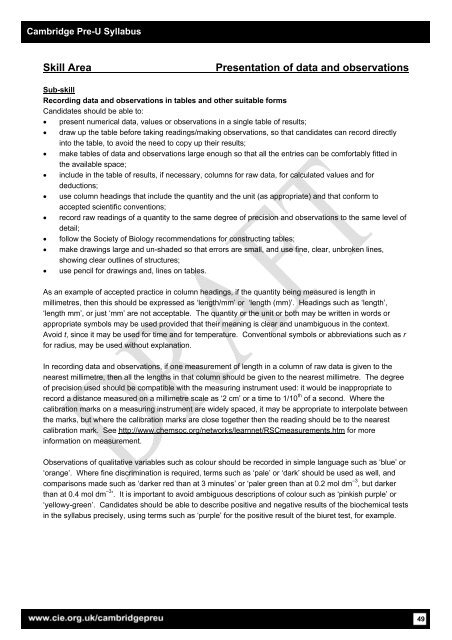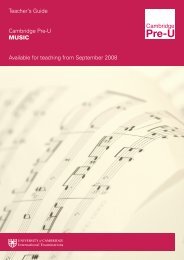Cambridge Pre-U Syllabus - Cambridge International Examinations
Cambridge Pre-U Syllabus - Cambridge International Examinations
Cambridge Pre-U Syllabus - Cambridge International Examinations
You also want an ePaper? Increase the reach of your titles
YUMPU automatically turns print PDFs into web optimized ePapers that Google loves.
<strong>Cambridge</strong> <strong>Pre</strong>-U <strong>Syllabus</strong><br />
Skill Area <strong>Pre</strong>sentation of data and observations<br />
Sub-skill<br />
Recording data and observations in tables and other suitable forms<br />
Candidates should be able to:<br />
• present numerical data, values or observations in a single table of results;<br />
• draw up the table before taking readings/making observations, so that candidates can record directly<br />
into the table, to avoid the need to copy up their results;<br />
• make tables of data and observations large enough so that all the entries can be comfortably fitted in<br />
the available space;<br />
• include in the table of results, if necessary, columns for raw data, for calculated values and for<br />
deductions;<br />
• use column headings that include the quantity and the unit (as appropriate) and that conform to<br />
accepted scientific conventions;<br />
• record raw readings of a quantity to the same degree of precision and observations to the same level of<br />
detail;<br />
• follow the Society of Biology recommendations for constructing tables;<br />
• make drawings large and un-shaded so that errors are small, and use fine, clear, unbroken lines,<br />
showing clear outlines of structures;<br />
• use pencil for drawings and, lines on tables.<br />
As an example of accepted practice in column headings, if the quantity being measured is length in<br />
millimetres, then this should be expressed as ‘length/mm’ or ‘length (mm)’. Headings such as ‘length’,<br />
‘length mm’, or just ‘mm’ are not acceptable. The quantity or the unit or both may be written in words or<br />
appropriate symbols may be used provided that their meaning is clear and unambiguous in the context.<br />
Avoid t, since it may be used for time and for temperature. Conventional symbols or abbreviations such as r<br />
for radius, may be used without explanation.<br />
In recording data and observations, if one measurement of length in a column of raw data is given to the<br />
nearest millimetre, then all the lengths in that column should be given to the nearest millimetre. The degree<br />
of precision used should be compatible with the measuring instrument used: it would be inappropriate to<br />
record a distance measured on a millimetre scale as ‘2 cm’ or a time to 1/10 th of a second. Where the<br />
calibration marks on a measuring instrument are widely spaced, it may be appropriate to interpolate between<br />
the marks, but where the calibration marks are close together then the reading should be to the nearest<br />
calibration mark. See http://www.chemsoc.org/networks/learnnet/RSCmeasurements.htm for more<br />
information on measurement.<br />
Observations of qualitative variables such as colour should be recorded in simple language such as ‘blue’ or<br />
‘orange’. Where fine discrimination is required, terms such as ‘pale’ or ‘dark’ should be used as well, and<br />
comparisons made such as ‘darker red than at 3 minutes’ or ‘paler green than at 0.2 mol dm –3 , but darker<br />
than at 0.4 mol dm –3 ’. It is important to avoid ambiguous descriptions of colour such as ‘pinkish purple’ or<br />
‘yellowy-green’. Candidates should be able to describe positive and negative results of the biochemical tests<br />
in the syllabus precisely, using terms such as ‘purple’ for the positive result of the biuret test, for example.<br />
49

















